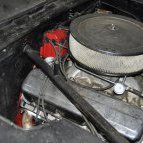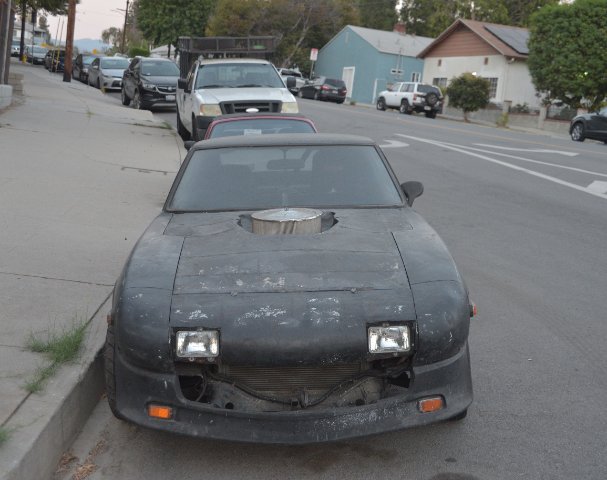-
Posts
825 -
Joined
-
Last visited
-
Days Won
7
Michael last won the day on June 22
Michael had the most liked content!
Profile Information
-
Gender
Not Telling
-
Location
was SW Ohio, now LA
Recent Profile Visitors
15163 profile views
Michael's Achievements
-
OK, here's a question on carb tuning. This past summer I visited a local tuning-shop, with open ended question about whether to rebuild my poorly-running carb (a Holley vacuum-secondary 750 cfm, basic model) or to buy something else. The technician recommended something with annular discharge boosters.... wouldn't even talk about anything else. Those are nice pieces... but also expensive. Asking AI, for annular vs. downleg, I get the standard AI answer: part obvious, part irrelevant, part condescending, part generic. How about human intelligence? So... who's running an annular discharge carb, such as this one: https://www.holley.com/products/fuel_systems/carburetors/street_strip/parts/Q-750-AN?utm_term=&utm_campaign=Holley+-+Non-Brand+All+SKUs+Performance+Max&utm_source=google&utm_medium=cpc&hsa_acc=7848552874&hsa_cam=22795333857&hsa_grp=&hsa_ad=&hsa_src=x&hsa_tgt=&hsa_kw=&hsa_mt=&hsa_net=adwords&hsa_ver=3&gad_source=1&gad_campaignid=22795335240&gbraid=0AAAAAD1FzSrgg0ZyXizSf4N8XZyF0lFbQ&gclid=Cj0KCQiArOvIBhDLARIsAPwJXOaTarreYIfCzmnZukhFJ0DfE902wysmGZtkPzPe60nCkk0bztd8cPkaAlw2EALw_wcB ? Oh, and good luck asking such questions in our "fuel delivery" subforum!
-

Help me evaluate this car for sale
Michael replied to z_noob's topic in S30 Series - 240z, 260z, 280z
Also not a facebook user here, but speaking in generalities: 1. In 2025, I would think seriously about the value proposition of buying a Z. Some of us have been dabbling in this hobby/affliction for nearly 30 years, starting back when these cars were cheap, plentiful in junkyards, and blank-canvases for modification. And today? Completely different game. Hard to tinker with a 50 year old car, just as a tinkering-car. Even harder to get the performance out of it, that was the stuff of our dreams in the 1990s. 2. These cars are becoming expensive. Even woebegone projects are becoming expensive. For the less-familiar, it's a costly trap! -
And there we have it! A full quarter century old! Old enough, to run for the US House of Representatives!
-
For people who still run old-school large-displacement V8s (we still exist, right?)... any thoughts on the somewhat-new (been around for 5-6 years) Edelbrock AVS2 carb? This has annular boosters on the primary-side, as opposed to dog-leg. Some articles here: https://www.motortrend.com/how-to/1908-inside-look-new-edelbrock-avs2-carburetor/ and here: https://www.hotrod.com/how-to/tuning-edelbrock-avs2-carb/ . The objective is throttle response, part-throttle drivability, and overall good manners with minimal fussing/tuning. Application is my perpetually-under-repair 454. I'd be looking at the 800 cfm version with manual choke. BTW, there are a few mentions of the AVS carb on HybridZ, but they're from 2014 and earlier.. for the old-style AVS (dog leg boosters on the primaries), for example here: https://forums.hybridz.org/topic/42427-edelbrock-issues/#comment-352025.
-
Ben, long-term projects take... a long term. So, here's another long-term voice of support! We're almost a quarter of the way done with the 21st century. Some folks started their Z projects back in the 20th century; should hopefully be done, in one capacity or another, before the 22nd! Question: what was wrong with the megasquirt, in terms of successfully operating your LS engine? And what does the Haltech do, that renders the improvement?
-

Long time, No SEZ - (Old Timers SEZ Shootout Roll Call) - just for kicks
Michael replied to Warren's topic in Non Tech Board
Not a participant myself, but I remember announcements for such events... and the era when "hybrid" meant engine from Brand A, into body of Brand B... having nothing to do with electric and internal combustion motors together in one vehicle. The competitive events, together with forums, seem to have been sadly vitiated. Most postings on this forum are now the occasional pop-up of elementary questions, that had been rigorously answered 20 years ago... or idle reminiscences, such as my own. And so many of the most senior/venerable/knowledgeable members have left, outright died, or just gone silent. What happened over the past 23 years? Well, some of us are still working on the same car that we had back in the 20th century... slowly. May one day even race it! -
One of the perennial debates is (or rather was, when this Forum was more active!) about front-rear weight distribution vs reducing polar moment of inertia. If the really heavy components, namely engine and transmission, move aft, then presumably the polar moment of inertia is reduced, even if the weight distribution becomes aft-biased. So, suppose that the car comes out to 47/53. Is that necessarily a disadvantage by itself? If so, is it a disadvantage if in combination with lower polar moment of inertia? Many people prefer the aesthetics of wider tires in the rear. Doesn't that actually lend itself to good remedy for being tail-heavy? I mean, it's just an aesthetic thing... but for a tail-heavy car, it might also turn out to be of practical value.
-
Lifeproject, given that you have a sturdy chassis/frame under the car already, would it perhaps be reasonable to cut/notch the firewall, for additional engine setback? That gives you better weight distribution, and more room under the hood... not just for the harmonic-damper issue, but cooling-room in front of the engine.
-
At the risk of being a crusty curmudgeon, what's the advantage of going all of the way to a 15x9 wheel, while limiting the tire series to 205 or 215? Currently I run 15x7 wheels, with 225-series tires... looks to be a decent match, both geometrically and aesthetically. With a 15x9 wheel, wouldn't it make more sense, to install something like a 275/50 tire? Like Hoosier R7, which is one of the few tires available in that size?
-
Not to be obtuse, but what's the benefit to "big tech"? Are they selling a product? If so, this seems like kludged and ineffective advertising. Are they trawling for data? Maybe, but then where's the harmful link that I'm supposed to click. Are they soliciting subscription to some service, or at least, traffic to a site? Again, no link. It just seems to be garbage for garbage's sake.
-
23 years!
-
Plugs did get fouled, before I figured out an enormous error in the ignition timing (off by something like 50 degrees, but that's a story for another thread). They no longer do. Oddly, the atrocious gas mileage is utterly the same, from before recognizing the timing problem, to after it was corrected. And the 2-3 mpg is from babying the car, never exceeding maybe 2500 rpm, never spinning the tires... start off at a traffic light in 3rd gear, then at 25 mph or so, shift to 5th (which is 1:1... it's a Doug Nash 5-speed). Also, there's no gasoline-smell when pulling the dipstick, either before running the engine, or after.
-
Carbureted V8 (1970s style big block Chevy) S30 here, with an older aluminum fuel-cell filled with foam, and mechanical fuel-pump driven off of the crankshaft. The engine runs OK – I think! – but the fuel mileage is atrocious. The manufacturer of the fuel-cell (Triangle Engineering) evidently no longer exists, but the unit much resembles this one, from Jeg’s: https://www.jegs.com/i/JEGS/555/15389/10002/-1?gclid=Cj0KCQjwhY-aBhCUARIsALNIC04c--8Ok-o0WtGmkpOwfZnzSK2Q5oxw3R6kGnD4y0a_MTBccgI4klgaAuATEALw_wcB There is no fuel-level gauge. It’s a single 3/8” fuel-line, no return. Because of the foam in the fuel-cell, I can’t visually inspect the fuel level. But upon filling say 3-4 gallons at a time, I almost invariably run out of gas after maybe at most 10 miles of driving. By “run out of gas”, I mean that the engine dies. Then, moving the carburetor throttle by hand, results in anemic or non-existing squirting into the primaries. This suggests that the carb’s fuel reservoirs are nearly empty. And yes, there’s whiff of fuel in the exhaust, as the engine almost certainly runs rich… but rich enough to get 2-3 mpg at part-throttle around town? So, the question: to diagnose if the fuel is magically evaporating/leaking/going down a wormhole, or actually reaching the carburetor, I would like to have a gauge in-line with the fuel line. Has anyone installed such a thing? Any thoughts? Lessons? A super-sophisticated (and expensive, probably) example is here: https://www.sentronics.com/applications/fuel-consumption-measurement/ . A janky one is here: https://www.amazon.com/DIGITEN-diesel-Liquid-Sensor-Counter/dp/B017CONTVS .
-

big block Z, "across the centuries"
Michael replied to Michael's topic in S30 Series - 240z, 260z, 280z
Thanks! There has indeed be a turning of the generations. Some of the most venerable early-members have either passed on to other engagements, or have literally passed-on. What BTW was your original user-name, if it's OK to ask? My daily driver is a first-gen Miata. The contrast between the Z and the Miata (it's parked immediately behind the Z, in the photo) is remarkable! The Miata feels light and unencumbered. The Z, though weighing 200 pounds less than its stock factory weight, and with a CG further aft than stock (due to firewall setback), feels like a... muscle car. And no, I don't mean the weight of the steering-effort. It's ineffable, but definitely there. Maybe a V8 Miata would have been a better option? Maybe, but that's actually a much harder swap. A local acquaintance bought a Lotus-7 kit car, with a 2.3L 4-cylinder Ford engine. It theoretically has a power to weight ratio comparable to that of the Z, and it's less than half of the weight. But for whatever reason, it feels less elfin and maneuverable than the Miata, but also accelerates less intensely than the Z. So maybe weight, or power to weight, aren't so obviously important - or at least, secondary in importance, to suspension design or driver interface and so on? So much to learn! Sadly, at the moment I'm in a small apartment, with no garage space. This limits tinkering to bare emergencies. Local ordinances mean that cars can't be parked curbside for longer than 72 hours, without moving. That means keeping-up with things, to enable to car to do a lap around the block, hunting for a new parking spot. But even a drive to the local track (Irwindale?) isn't tractable. What would have been great, would be to find a local buddy, to work together and the bounce-around ideas! -

big block Z, "across the centuries"
Michael replied to Michael's topic in S30 Series - 240z, 260z, 280z
It's been nearly a year, so perhaps an update is fitting. Recent changes have been more a matter of maintenance than of car-crafting, modification, enhancement or technical progress. These include a refresh with stock brakes (master cylinder, rear slave cylinders, pads and shoes, front calipers), fixing the leak at the engine oil-pan and timing cover, and raising the driver's seat a bit higher-up, to improve visibility and comfort. The next struggle is figuring out why the accessory belt (water pump and alternator) keeps getting thrown or shredded. I re-trued the races (correct term?) for the water pump pulley, and installed a new alternator and pulley - factory Delco parts. This is all part-number-referenced to a 1978 Chevy Suburban, with 454. One update of note... by word of mouth, the famous Sammy Malouf took a look at my engine. He runs a fancy, high-profile operation, so I could not in good conscience except much attention to a sappy little jalopy like mine. But Sammy took a good hour to listen to the engine, adjust the timing and make other changes/suggestions, each of which were small individually, but substantial in aggregate. This further compounds the fact, that good tuning and attention to detail, are which distinguish a stalled and failed project, from a smashingly successful one. Or in other words, the execution of craftsmanship can be more important than initial engineering an conceptualization. Or still in other words, the better car is that one that's done right, and not necessarily the one that's optimized on paper! Yeah, it only took 24 years to realize that! Here's a photo of the humble machine, on a Los Angeles street....






